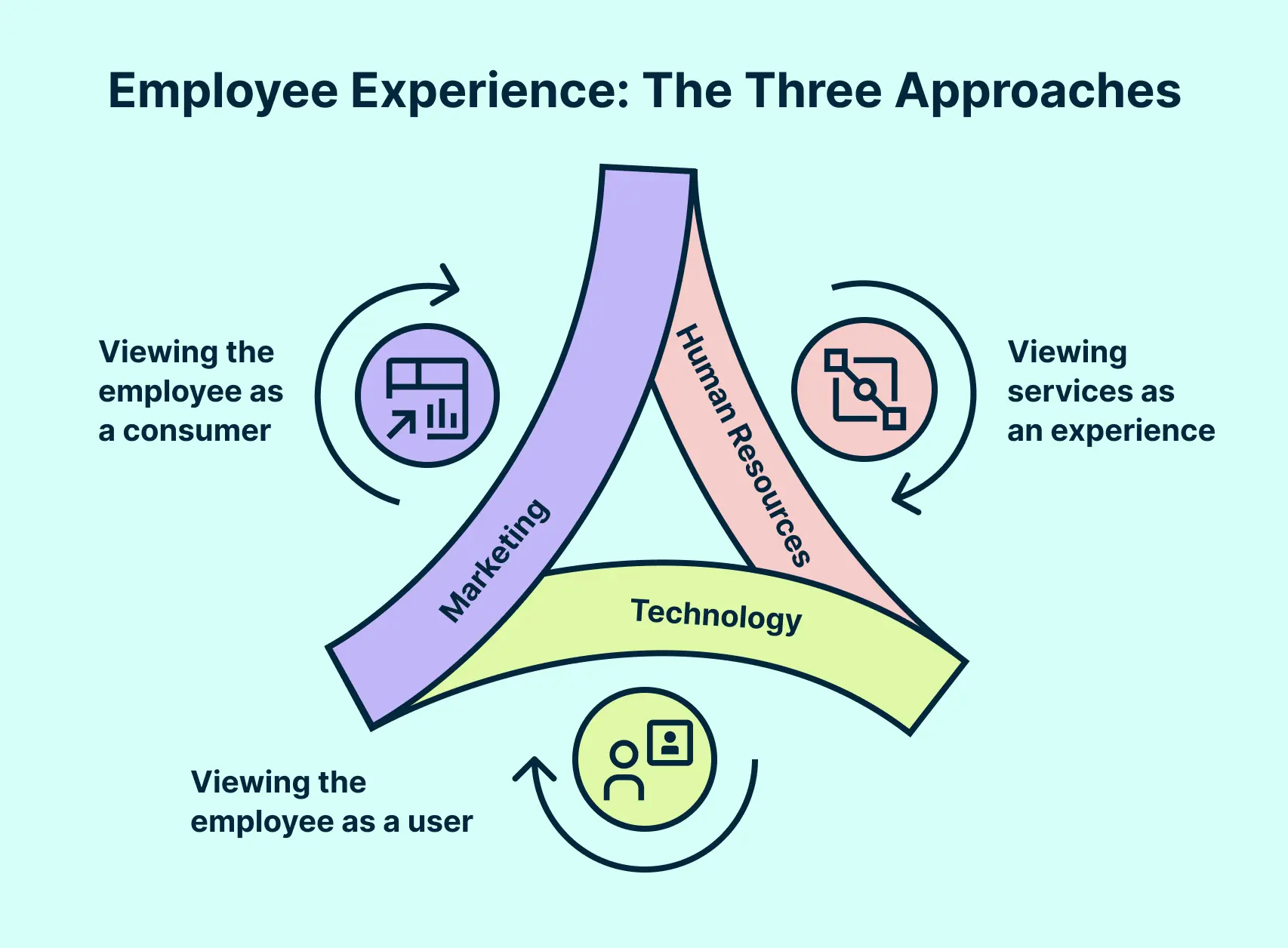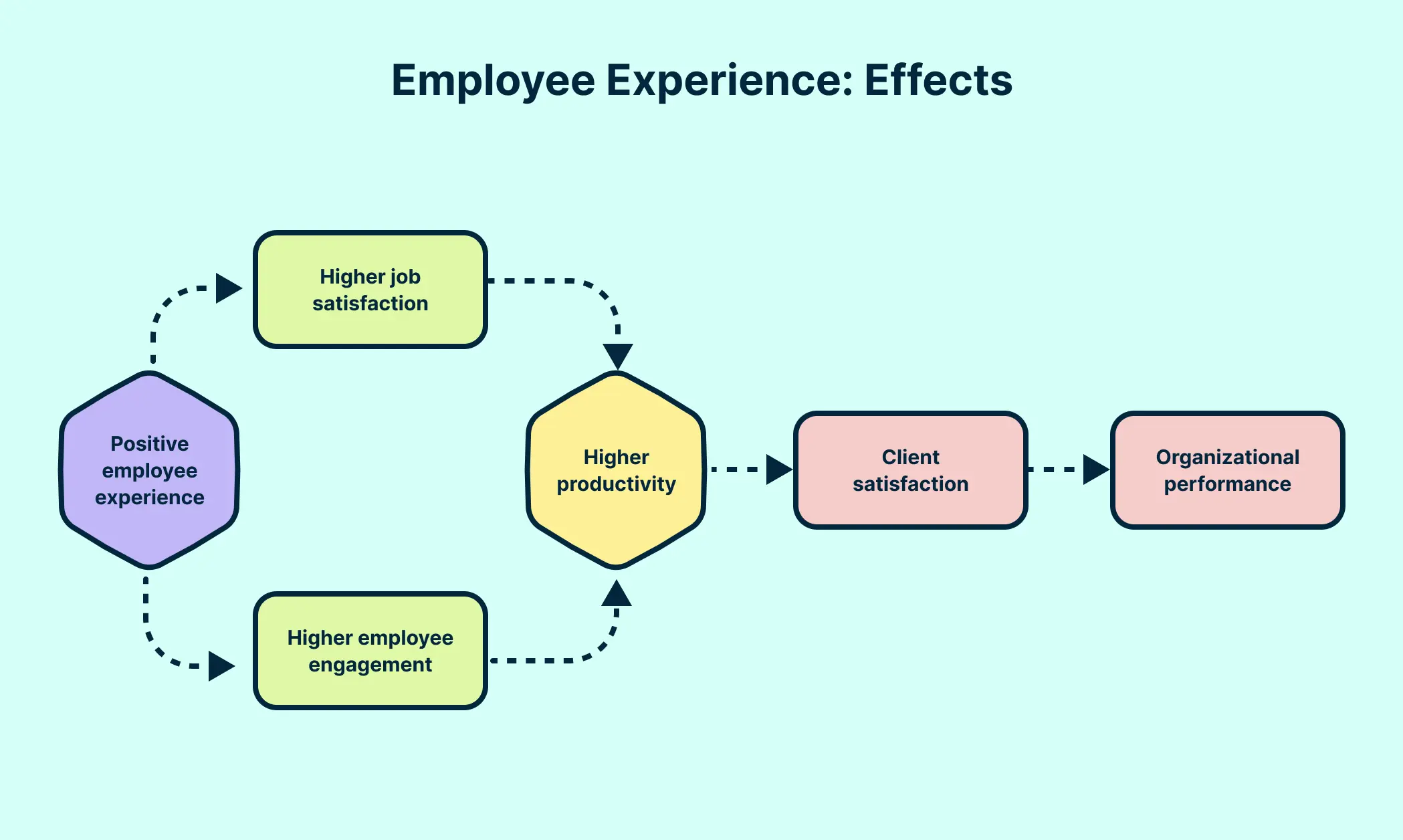What is Employee Experience?
Employee Experience (EX) refers to the sum of all interactions an employee has with an organization throughout the employee lifecycle. From the initial stages of recruitment to the final moments of offboarding, each touchpoint contributes to the overall employee experience.
A comprehensive understanding of employee experiences encompasses both the professional and personal aspects of an employee’s journey within and outside the organization. This holistic view is crucial to recognizing the areas where employers can make impactful changes.

The Importance of Employee Experience

A positive employee experience is a significant driver of overall job satisfaction and employee retention. When employees feel valued and engaged, they are more likely to stay committed to the company’s mission, which in turn leads to higher productivity and better performance outcomes. This is why companies that invest in EX often see gains in innovation, customer satisfaction, and profitability.
Furthermore, a well-designed employee experience aligns employees’ personal and professional goals with the broader objectives of the organization. By ensuring that employees feel a sense of purpose and alignment with the company’s mission, businesses can foster a loyal and motivated workforce.
Overall, improving employee experience is not just about creating a better work environment; it’s a strategic necessity for any organization aiming for long-term success.
Linking Employee Experience with Organizational Goals
A strong EX is deeply intertwined with organizational objectives. When employees are in synergy with the company’s mission and goals, their work becomes aligned with the organization’s broader ambitions. This alignment can lead to higher customer satisfaction, as employees who are engaged and committed are more likely to provide exceptional service and support.
Elements of Employee Experience Design
Feedback
Feedback is critical to understanding employee sentiment and identifying areas for improvement. A well-rounded feedback program should consist of both qualitative and quantitative feedback, allowing for a comprehensive view of employee experiences. Regular, anonymous surveys, coupled with action on recommendations, creates a transparent and trusting environment. Feedback should be collected consistently across various stages of the employee lifecycle, ensuring ongoing engagement and continuous improvement.
Training
Training is vital in closing skill gaps and supporting career development, which in turn enhances employee satisfaction and retention. Effective training methods include social media, video tutorials, podcasts, and online tests augmented with user-friendly virtual formats. Branded and relevant content that is sometimes mandatory but always supported with flexibility ensures better engagement.
Key Performance Indicators (KPIs)
KPIs offer a transparent, objective, and measurable basis for evaluating employee performance. These indicators should be mutually agreed upon with employees and should align with both individual and organizational goals. Regular reviews and adjustments based on changing business needs ensure that KPIs stay relevant.
Also read how to set KPIs for your team.
Company Culture
A positive company culture integrates all elements of employee experience design by bringing consistency to feedback, training, and engagement processes. It fosters trust, loyalty, and satisfaction, leading to a more motivated workforce.
Feedback: Collect and act on comprehensive feedback.
Training: Provide engaging and flexible learning opportunities.
KPI’s: Set and review clear performance metrics.
Company Culture: Foster a consistent and positive environment.
Steps of Employee Experience Design
Step 1: Define Clear Objectives and Goals
The first step in employee experience design is establishing clear objectives and goals. This involves setting specific, measurable, achievable, relevant, and time-bound (SMART) goals that align with both employee needs and organizational goals. Define desired outcomes such as improving employee engagement, increasing productivity, or reducing turnover rates. Understanding the ‘why’ behind your objectives helps create a focussed strategy.
Step 2: Gather Employee Feedback
Collecting feedback from employees is crucial for understanding their experiences and identifying areas for improvement. Implement regular feedback mechanisms such as surveys, focus groups, and anonymous feedback tools. Utilize both qualitative and quantitative data for a comprehensive view. Ensuring anonymity encourages honest responses and can reveal valuable insights into employee sentiments.
Step 3: Segment Your Employees into Cohorts
To tailor your employee experience design effectively, segment your workforce based on various characteristics such as job roles, departments, or demographics. This enables the creation of personalized experiences that meet the unique needs of different employee groups. For example, the onboarding process for new hires may differ significantly from the career development programs for tenured staff.
Step 4: Map the Employee Journey
Mapping the employee journey involves identifying all the stages an employee goes through from recruitment to offboarding. Recognize critical touchpoints like onboarding, training, performance reviews, and career development opportunities. This helps in understanding employee experiences at each stage and creating customized strategies to enhance these interactions.
visual tools to optimize employee journey mapping.
Step 5: Identify Critical Touchpoints
Critical touchpoints in the employee lifecycle are moments that significantly impact employee satisfaction and engagement. These include recruitment, onboarding, annual performance reviews, and career advancement opportunities. By optimizing these touchpoints, organizations can make a lasting positive impression on their employees.
Step 6: Develop Employee Personas
Creating detailed employee personas involves identifying the needs, goals, motivations, and frustrations of different employee segments. This human-centered approach ensures that the strategies you implement are relevant and resonate with your diverse workforce. Personas help in personalizing experiences and improving overall satisfaction.
Step 7: Craft an Employee Value Proposition
An employee value proposition (EVP) clearly articulates what employees can expect from the organization. It should highlight the benefits, opportunities, and work environment that the company offers. A strong EVP is key to attracting and retaining top talent.
Step 8: Design Customized Experiences for Different Types of Employees
Customized experiences for various employee segments ensure that individual needs and preferences are met. This could include tailored onboarding programs, flexible work arrangements, or personalized career development plans. Such customization enhances engagement and satisfaction.
Step 9: Provide In-App Guidance and Self-Help Performance Support
Utilizing digital tools like in-app guidance and self-help resources can significantly improve employee experience. Platforms such as Creately offer real-time instructions and support, helping employees navigate tasks and develop skills independently. This autonomy fosters a more engaging and empowering work environment.
Step 10: Implement Continuous Feedback Loops
Establish regular feedback mechanisms to continuously identify and address issues. This could range from weekly check-ins to bi-annual reviews. Continuous feedback loops help in maintaining a pulse on employee sentiment and fostering ongoing development.
Step 11: Communicate and Train Employees
Effective communication and training are essential for the success of any employee experience design. Ensure that employees are well-informed about the company’s goals, processes, and available resources. Providing ongoing training and development opportunities keeps employees engaged and supports their career growth.
Step 12: Empower Leadership and Managers
Empowering leaders and managers is crucial for driving employee experience strategies. Provide them with the tools, training, and authority to implement and support these initiatives effectively. Leadership buy-in is vital for fostering a positive and cohesive organizational culture.
Step 13: Iterate and Improve
Employee experience design is an ongoing process. Regularly review and refine your strategies based on feedback and changing organizational needs. Employ tools like Creately for continuous improvement through visual planning and data-driven insights. This iterative approach ensures that your employee experience remains relevant and effective over time.
How to Use Creately to Streamline Employee Experience Design
Implementing a seamless Employee Experience Design (EXD) strategy can be streamlined using Creately’s robust visual collaboration tools. With features like visual collaboration, whiteboarding, and an infinite canvas, Creately ensures every step of your EXD process is efficient and engaging.
Visual Collaboration: Creately empowers teams to ideate, plan, and document their EXD strategies visually. Using visual boards, stakeholders can brainstorm and develop strategies in real-time, ensuring all voices are heard.
Whiteboarding: The whiteboarding feature in Creately allows HR professionals and organizational leaders to map out employee journeys, identify critical touchpoints, and visualize feedback loops effectively.
Infinite Canvas: This feature provides unlimited space to unroll comprehensive EXD plans, accommodate future changes, and integrate various project elements without constraints.
Centralized Information: All EX-related data, notes, and diagrams can be stored one accessible workspace, fostering seamless information sharing across departments.
By leveraging these features, HR professionals and managers can foster a more collaborative environment, drive innovation, and ensure continuous improvement through visual planning. It’s a holistic approach that aligns with modern EX principles, making it invaluable for companies dedicated to enhancing their employee experience.
Case Study: The Talent Acquisition Experience
Challenges in Talent Acquisition Process
In our exploration of employee experience design, one critical area that stands out is talent acquisition. Many organizations struggle with outdated methods of recruiting, characterized by vague job descriptions, cumbersome interview processes, and inconsistent candidate feedback. These inefficiencies not only deter potential talent but also create a negative first impression of the company.
Solutions and Implementations
To address these challenges, the company focused on implementing a personalized and technology-enabled recruitment process. Key solutions included:
Transitioning to virtual and AI-powered interviews to streamline the selection process and reduce time-to-hire.
Utilizing multiple screening tools to ensure a more robust candidate evaluation.
Implementing digital candidate and onboarding portals for seamless information flow and enhanced candidate engagement.
Creating tailored communication strategies to keep candidates informed and engaged throughout the hiring process.
Outcomes and Lessons Learned
The redesign of the talent acquisition process led to several positive outcomes. We observed a notable increase in the quality of candidates and a reduction in the time-to-hire. Candidates reported feeling more supported and informed throughout the process, leading to higher acceptance rates.
This case study underscores the importance of leveraging both EX principles and advanced tools to optimize talent acquisition. By doing so, organizations can create a compelling and efficient recruitment experience, ultimately contributing to better employee engagement and retention.
Wrapping Up
Investing in a robust employee experience isn’t merely about keeping employees happy—it’s about driving sustainable business success. The intertwining of EX with organizational strategies and goals fosters a culture of continuous improvement, enabling companies to thrive in a competitive landscape.






